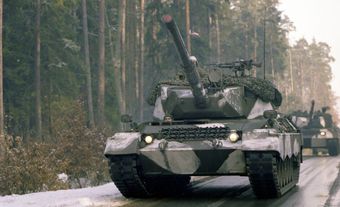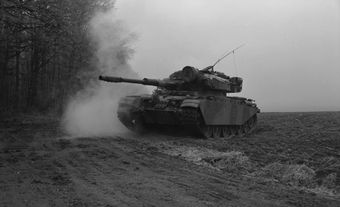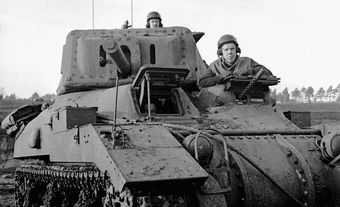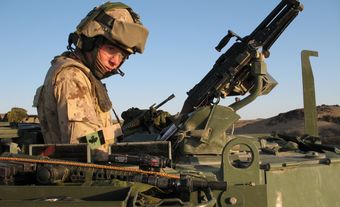The Leopard 2 tank is the successor to the Leopard 1. It was first produced in 1979 and has entered service with several NATO and non-NATO nations. Canada acquired Leopard 2 tanks in 2007 and continues to operate them today.

Development
In West Germany, development of the Leopard 2 was in-progress even as the Leopard 1 entered service in 1965. It is not a revolutionary design, but an evolution from its predecessor. Although the chassis was improved, it remained similar to the Leopard 1. The biggest difference is in the turret. It was redesigned to accommodate the new German Rheinmetall 120 mm smoothbore cannon. The turret was also fitted with composite armour for added protection against modern threats like anti-tank guided missiles. This design choice was a departure from the more lightly armoured Leopard 1 turret. Armament includes two 7.62 mm machine guns — one mounted externally on the turret and one mounted coaxially with the main gun.
The Leopard 2 weighs 62.3 tonnes and is powered by a 1,500-horsepower diesel engine with an automatic transmission. Like the Leopard 1, its engine can be changed in a short time, anywhere from 15 to 35 minutes. It has a road range of about 450 to 550 km and a top speed of around 72 km/h.
Use and Variants
Germany built more than 3,500 Leopard 2 tanks. Besides Germany and Canada, 16 other countries fielded the Leopard 2, including Austria, Denmark, Finland, Greece, the Netherlands, Norway, Poland, Spain, Sweden and Switzerland.
The Leopard 2 was produced in 9 models. The Germans also produced several specialized vehicles. Among them are the Büffel (Buffalo) armoured recovery vehicle (ARV) to repair and recover tanks and the Kodiak armoured engineer vehicle (AEV).
Leopard 2 in Canadian Service
Only Canada, Germany and Denmark have deployed Leopard 2 tanks in an active combat theatre. In 2007, Germany loaned 20 Leopard 2 tanks to Canada at no cost. These vehicles were upgraded to the A6M CAN standard with enhanced mine protection. Canada also acquired two Buffalo ARVs to support operations in Afghanistan. (See Canada and the War in Afghanistan.) Canada subsequently bought 20 surplus Leopard 2A6 tanks from the Netherlands and gave them to Germany to replace the loaned tanks.

Seven Canadian Leopard 2 squadrons served in Afghanistan between February 2007 and July 2011, when Canada’s combat mission to Afghanistan ended. The tanks remained in theatre, while personnel were rotated every six months.
In 2009, Canada acquired 80 Leopard 2A4 and 20 A6 tanks from the Netherlands. Some vehicles were modified with crew cooling systems to allow them to operate in the Afghanistan heat. Extra armour across the glacis plate, hull deck and lower hull behind the suspension was fitted; the side armour was enhanced. The running gear was improved. An enhanced electrical system was also installed, which included an all-electric turret drive.
In late 2017, Canada received the first of 18 Leopard 2 AEVs to replace Leopard 1 Badger AEVs. In Canadian Army service, they are known as the Ram.
In the context of the ongoing Russo-Ukrainian War, Canada announced in early 2023 that it would donate eight Leopard 2 tanks and an armoured recovery vehicle to support Ukraine. The contribution is part of an international effort to equip Ukraine with Western main battle tanks.

 Share on Facebook
Share on Facebook Share on X
Share on X Share by Email
Share by Email Share on Google Classroom
Share on Google Classroom



